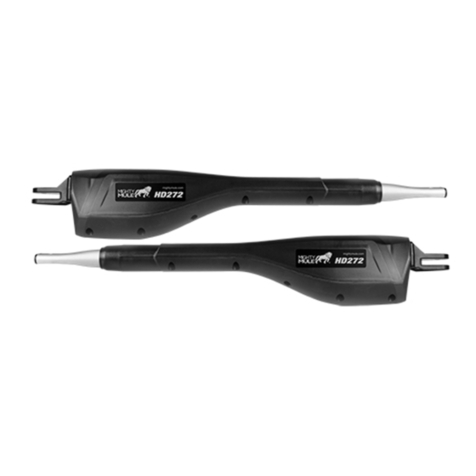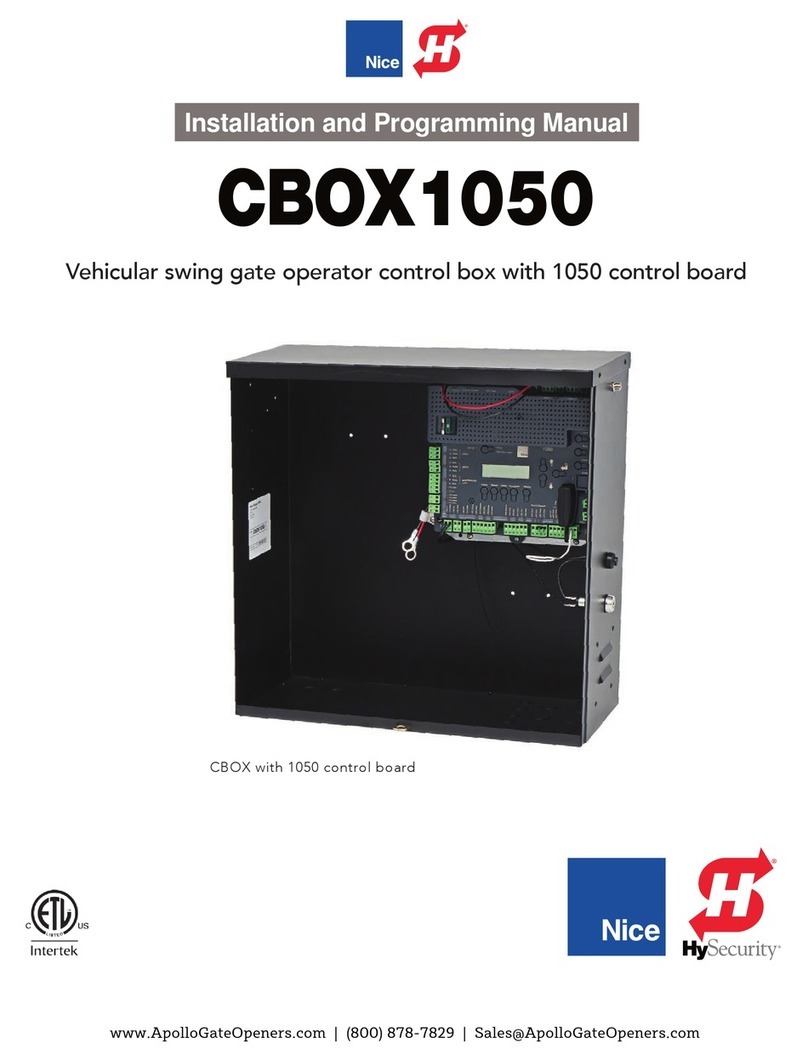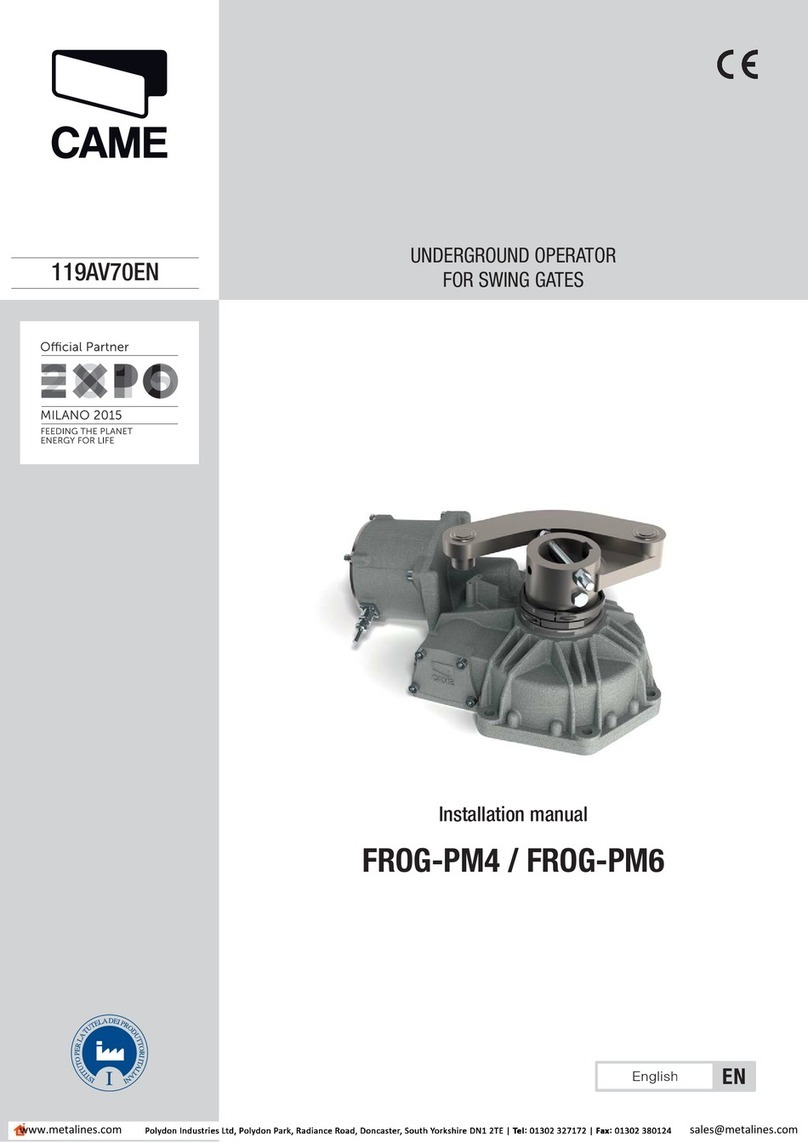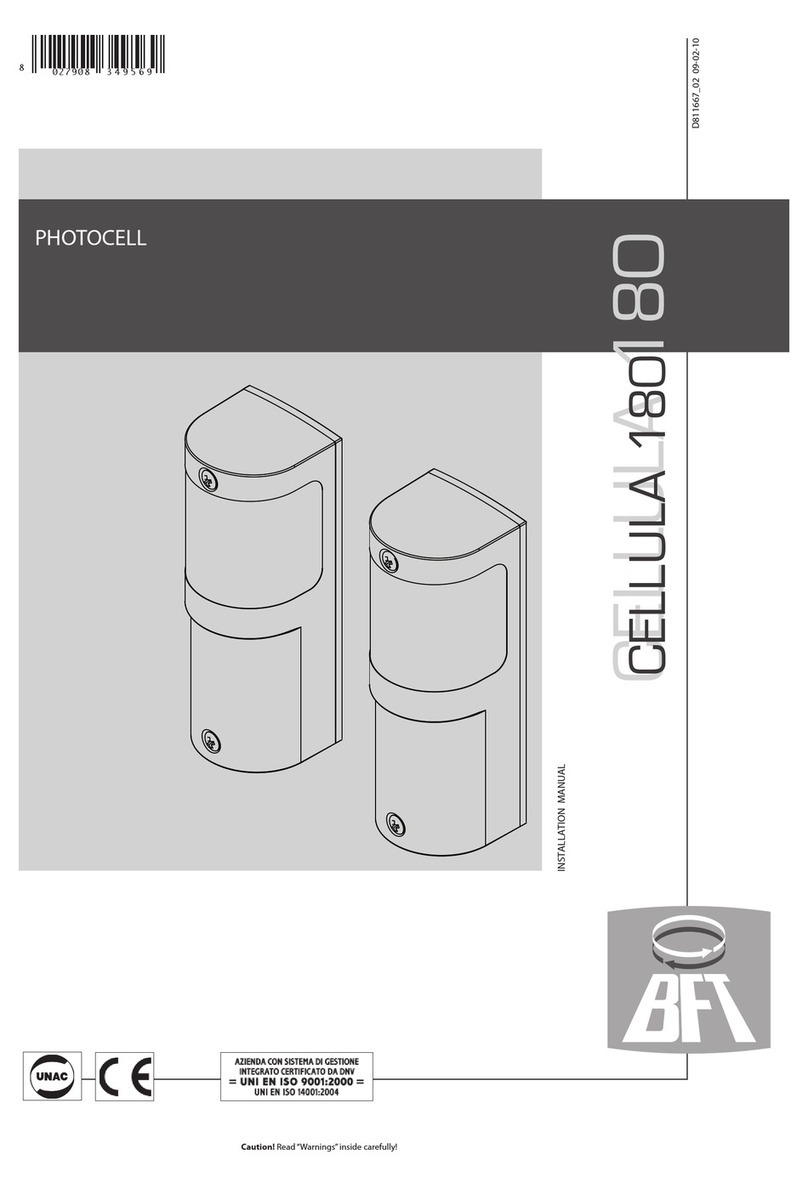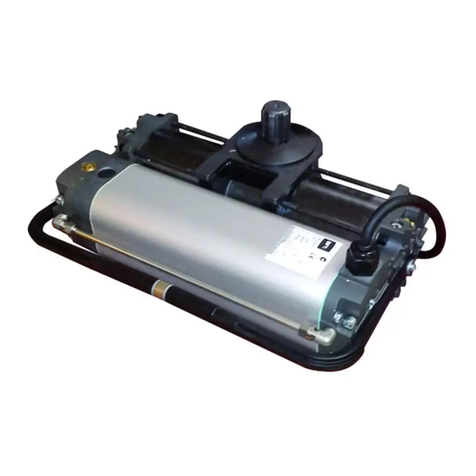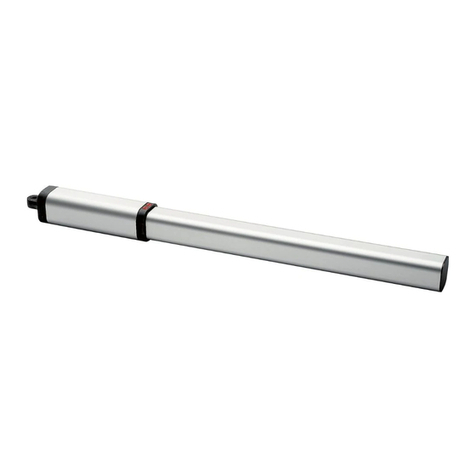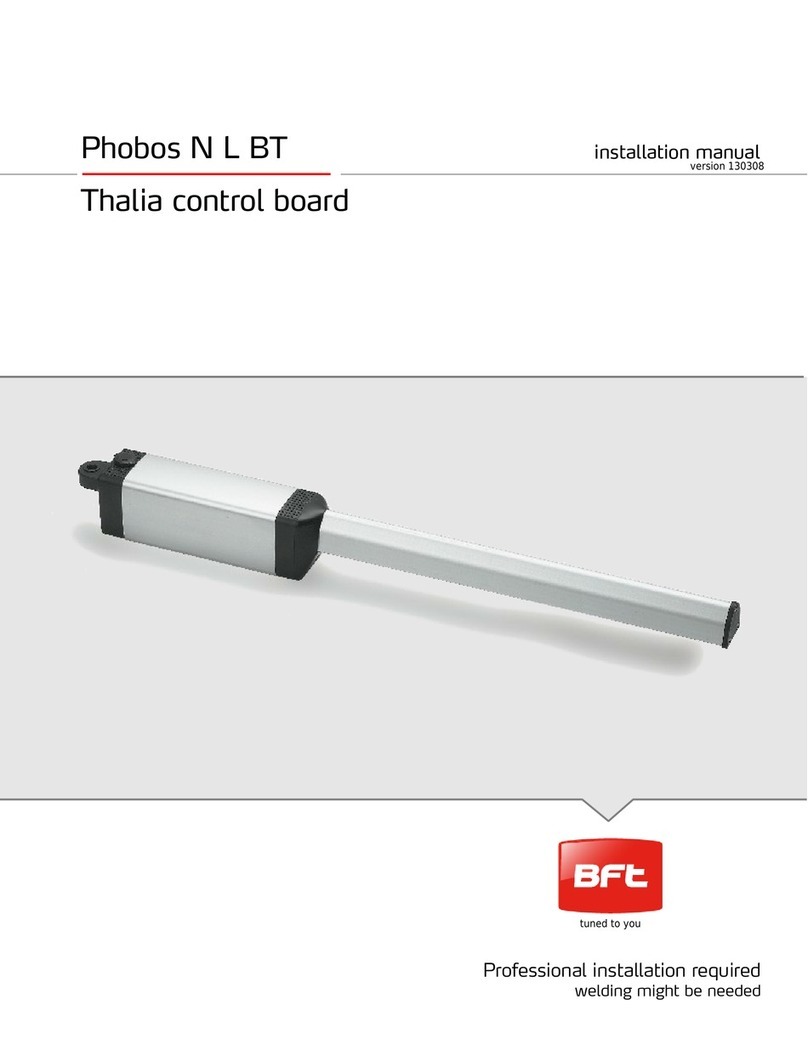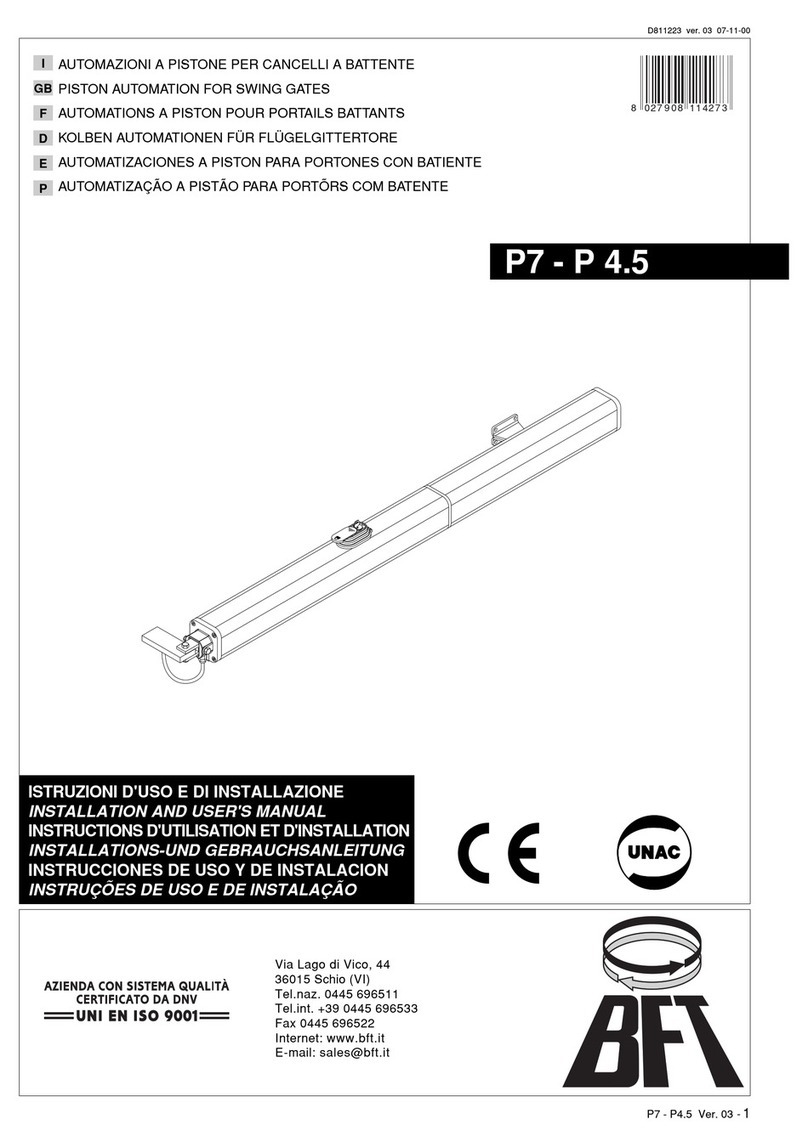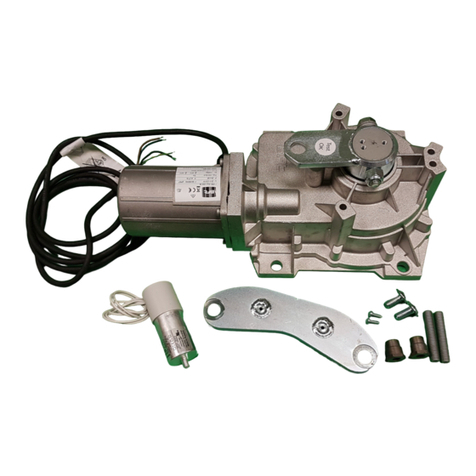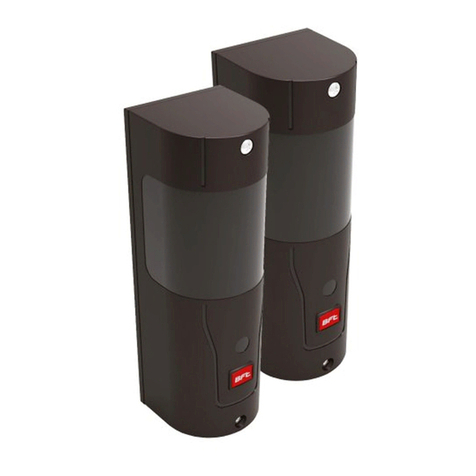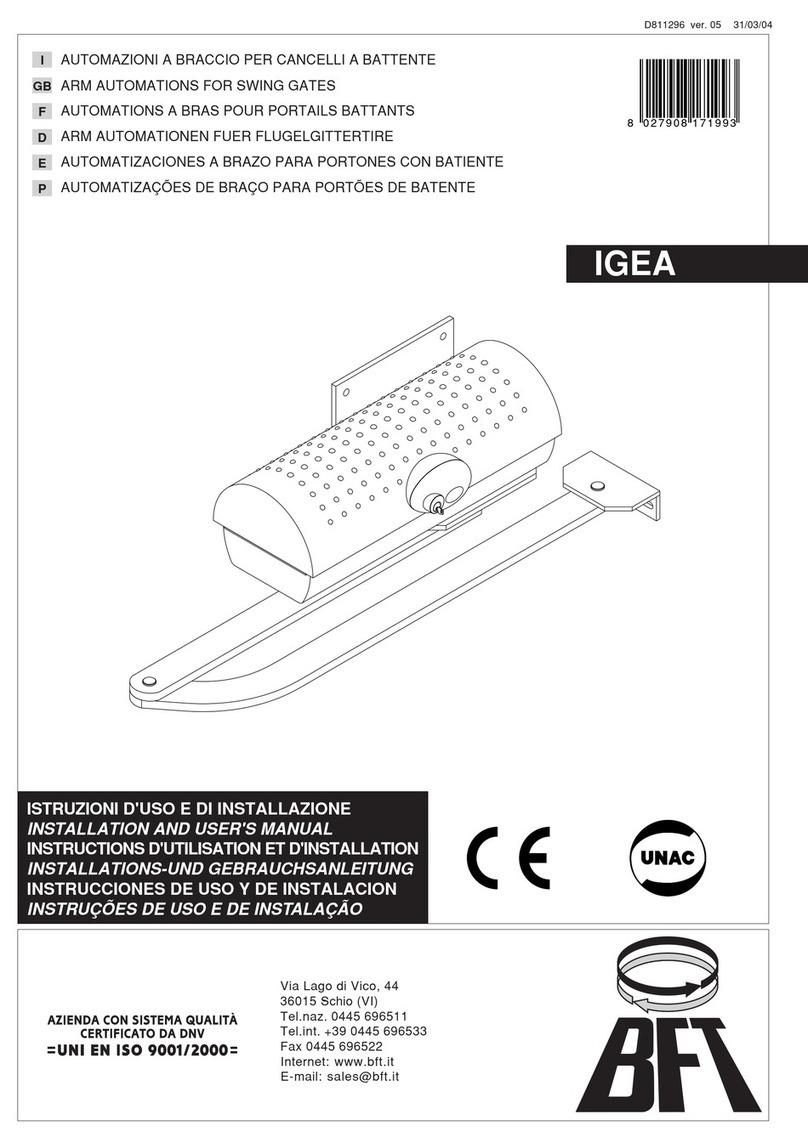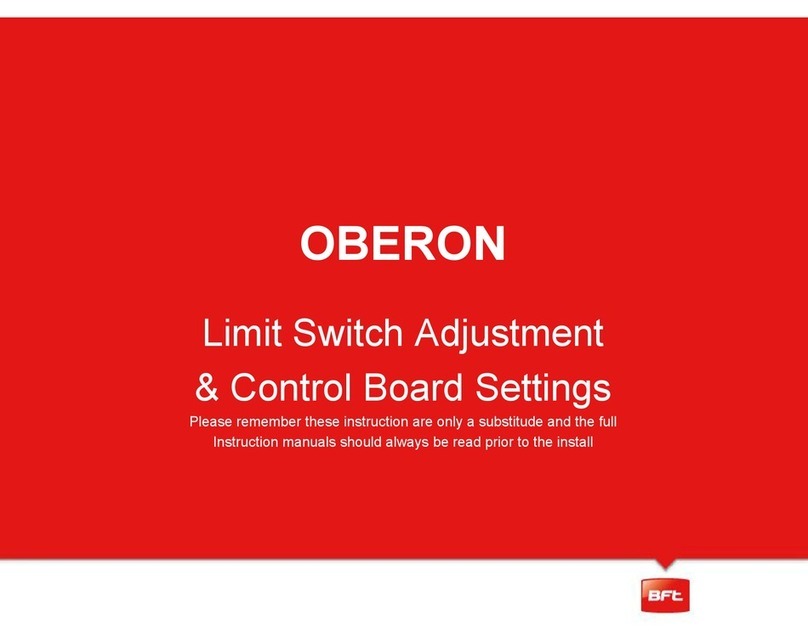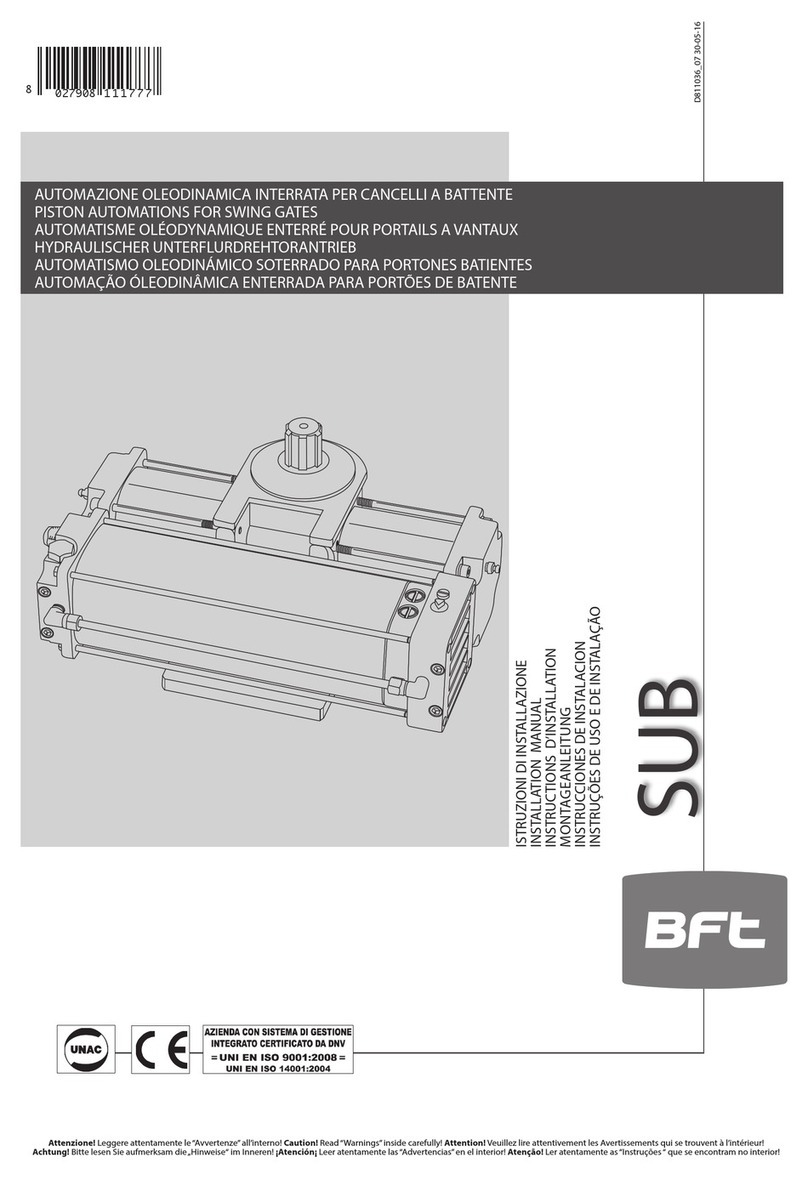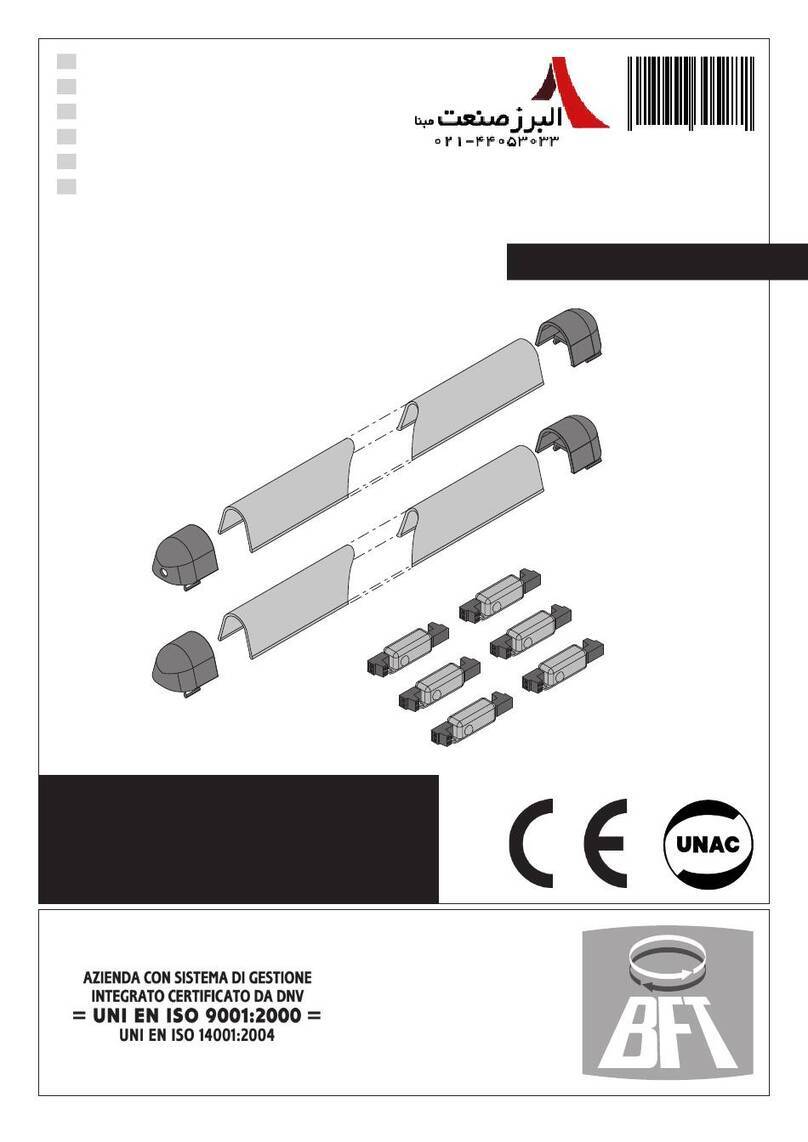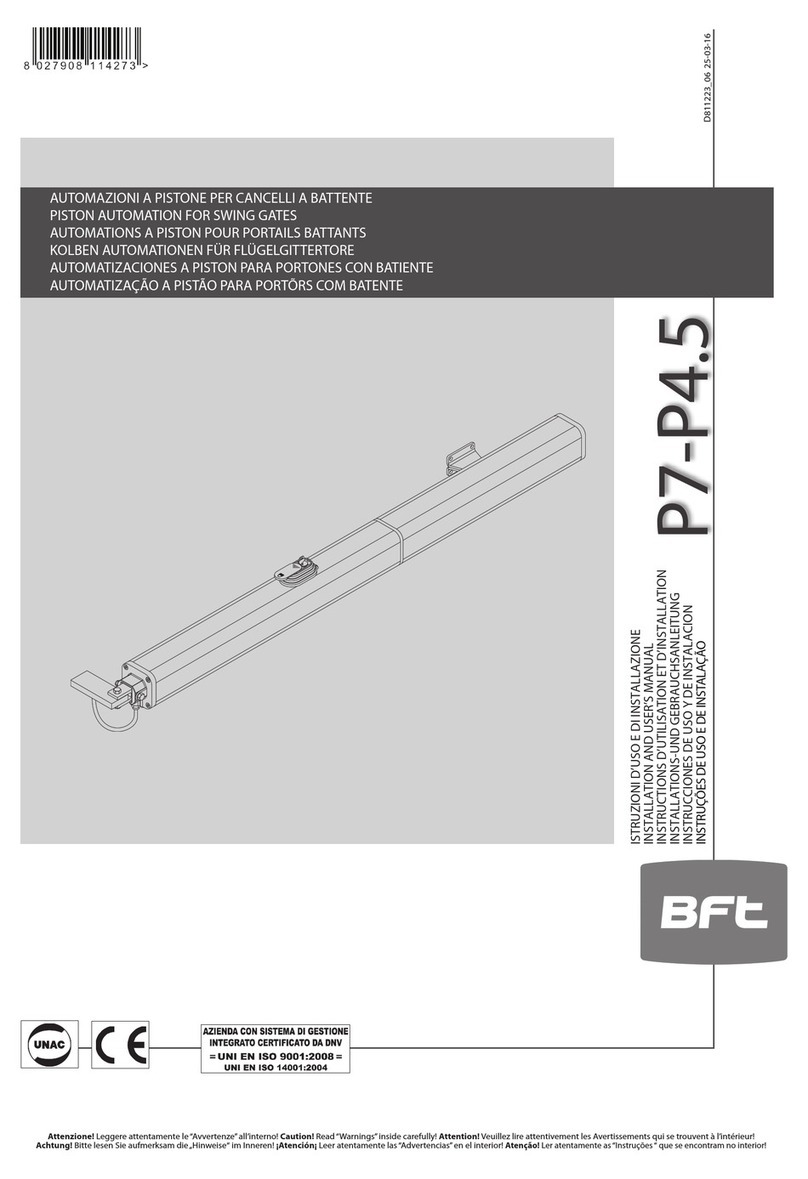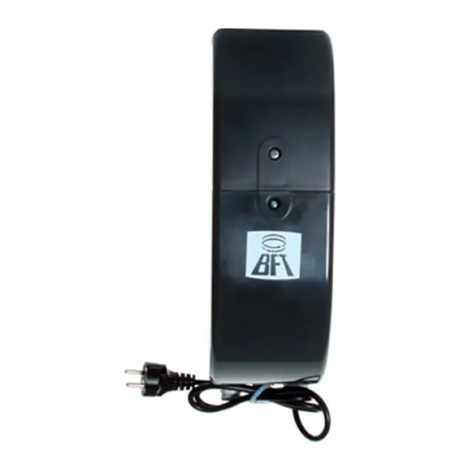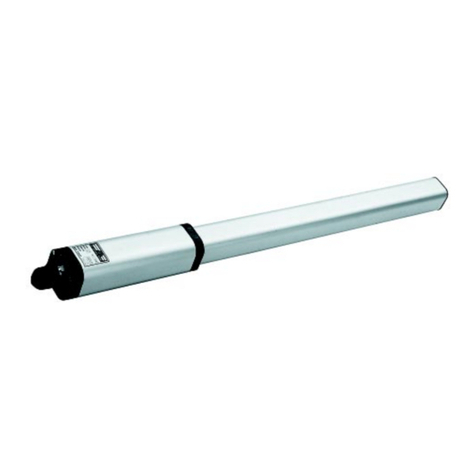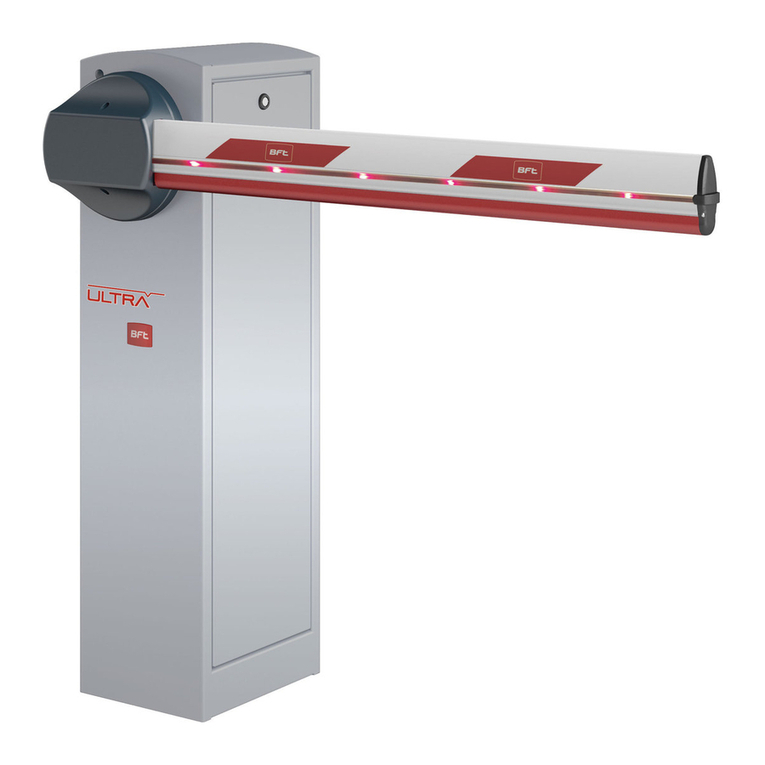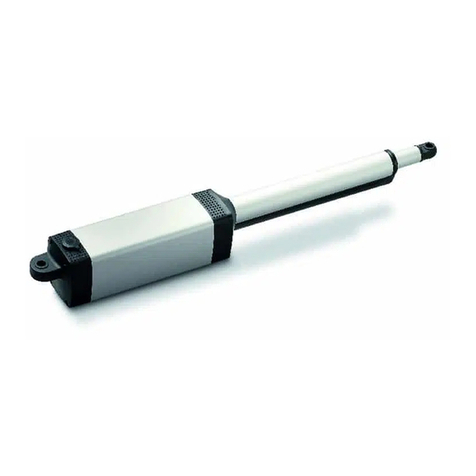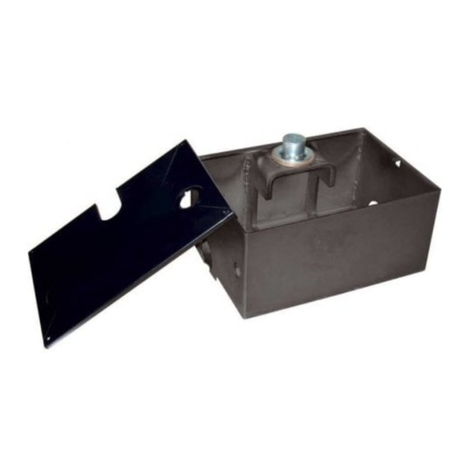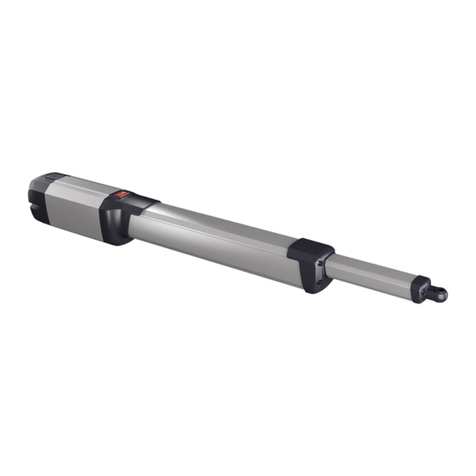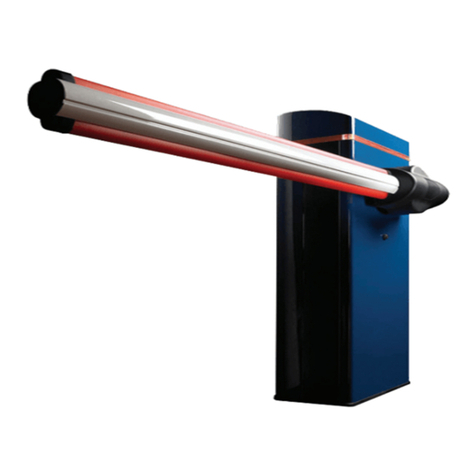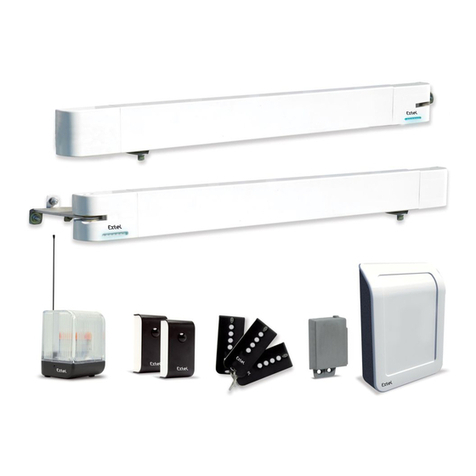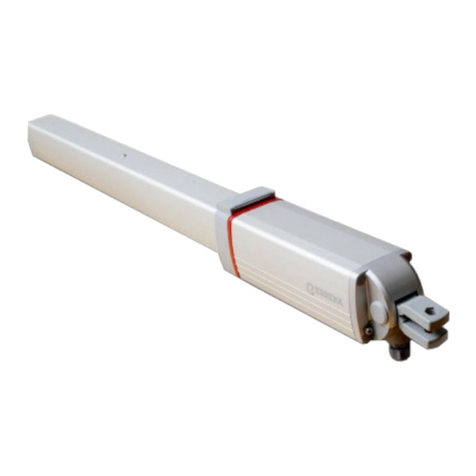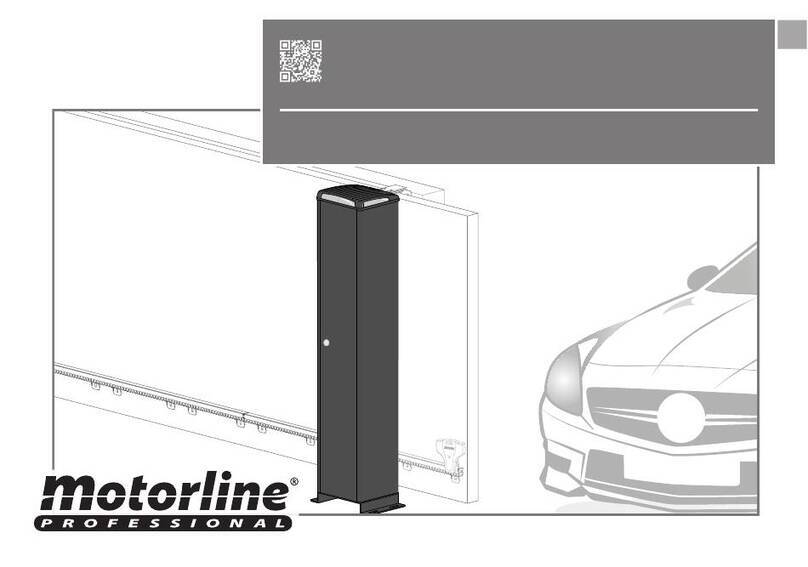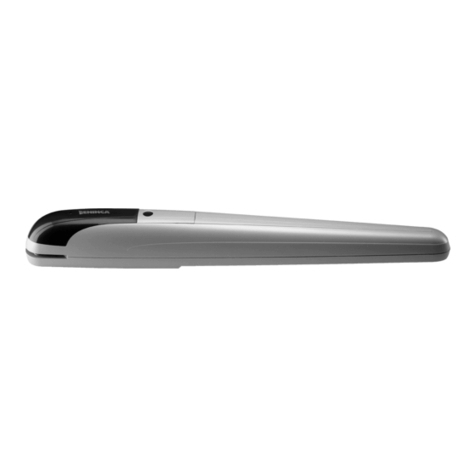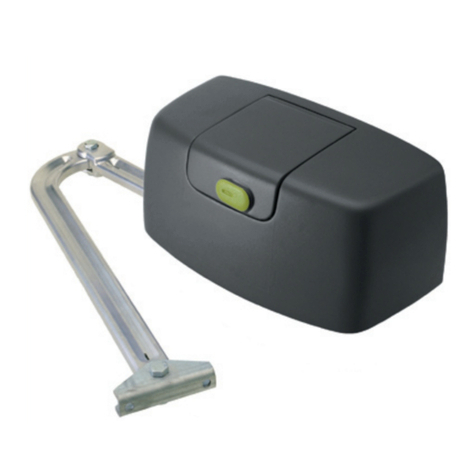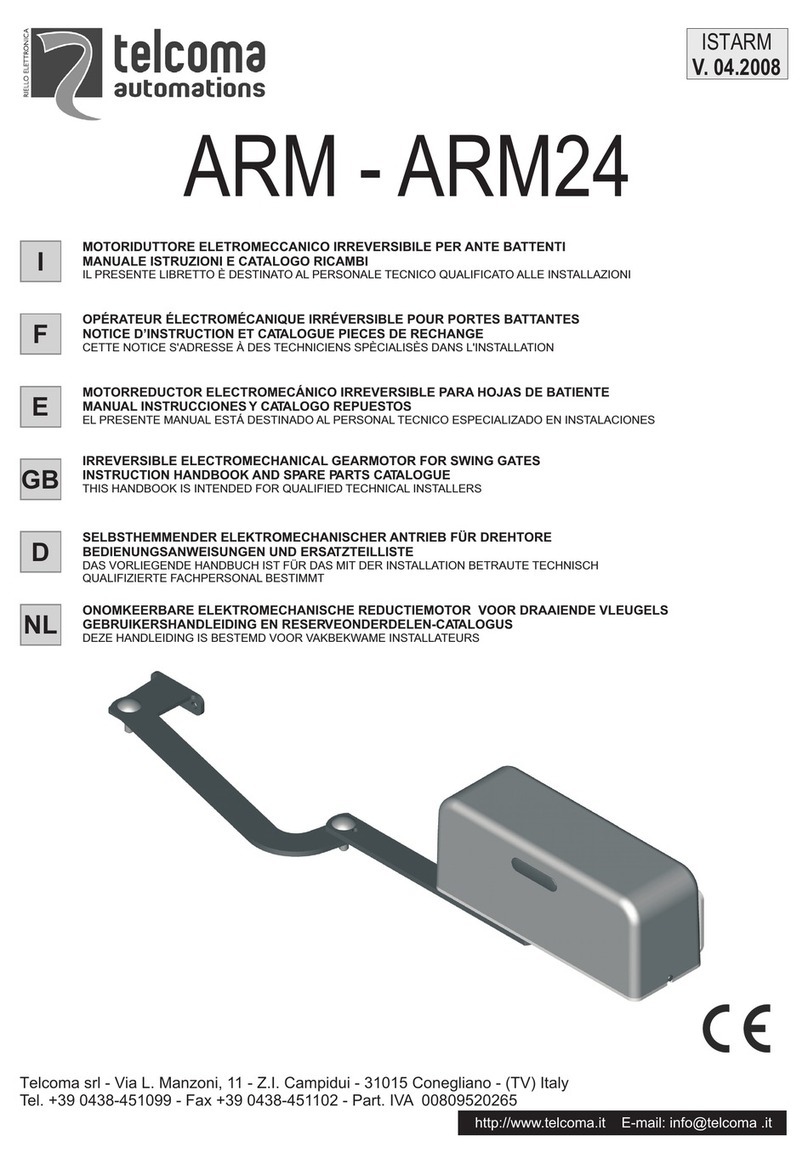
10 -
DEIMOS BT Ver. 04
D811314_04
MANUALE PER L’INSTALLAZIONE
ITALIANO
• Che la guida superiore permetta il giusto gioco con il cancello per garan-
tire un movimento regolare e silenzioso.
• Che siano posizionate le battute di arresto in apertura e chiusura.
• Che la posizione stabilita per il fissaggio del motoriduttore, consenta di
eseguire la manovra di emergenza in modo agevole e sicuro. Nel caso
gli elementi verificati non soddisfino quanto sopra descritto, procedere
alla loro sistemazione o, se necessario, allo loro sostituzione.
ATTENZIONE: Ricordarsi che la motorizzazione è una facilitazione
dell’uso del cancello e non risolve problemi dovuti a difetti e deficien-
ze di installazione o di mancata manutenzione del cancello stesso.
Togliere il prodotto dall’imballo e verificarne l’integrità. Se il prodotto non è
integro, rivolgersi al proprio rivenditore. Ricordarsi di smaltire i suoi com-
ponenti (cartone, polistirolo, nylon, ecc.) secondo le disposizioni delle
norme vigenti.
5) ANCORAGGIO DELLA PIASTRA BASE
5.1) Posizione standard
• Predisporre uno scavo dove eseguire la piazzola di cemento con anne-
gati i tirafondi della piastra base per il fissaggio del gruppo riduttore
(fig.3). Se il binario di scorrimento è già esistente, lo scavo deve essere
ricavato in parte anche nel getto di fondazione del binario. In questo
modo, un eventuale cedimento del getto di fondazione del binario farà
abbassare anche la base del motoriduttore mantenendo così il gioco tra
pignone e cremagliera (circa 1-2mm).
• Posizionare la piastra base rispettando le quote riportate in fig.4.
Il simbolo del pignone stampigliato nella piastra base deve essere visi-
bile ed orientato verso il cancello. Ciò garantisce anche la corretta posi-
zione delle canalette per i collegamenti elettrici.
• Lasciare i tubi flessibili previsti per il passaggio dei collegamenti elettrici
sporgenti dalla piastra base .
• Per mantenere in posizione corretta la piastra base durante la posa in
opera, può risultare utile saldare due piatti di ferro sotto il binario sui quali
poi, saldare i tirafondi (fig.3).
• Eseguire un getto di calcestruzzo, facendo in modo che il getto della
piastra base faccia corpo unico con quello del binario del cancello.
• Controllare accuratamente:
Le quote di posizionamento.
Che la piastra base sia ben livellata.
Che i 4 filetti dei prigionieri siano ben puliti dal cemento.
Lasciare rapprendere il getto.
5.2) Altre posizioni
Il motoriduttore può essere posizionato in diversi modi. A titolo di esempio,
in fig.5 è rappresentato un tipo di installazione particolare. Nel caso il
motoriduttore non venga fissato a livello del binario di scorrimento (Posi-
zione standard), si deve garantire un sicuro fissaggio del motoriduttore in
relazione anche alla posizione del cancello, in modo da mantenere un
corretto gioco (1-2mm) tra cremagliera e pignone. Deve essere garantito il
rispetto delle norme di sicurezza vigenti per quanto riguarda le persone,
animali e cose, e in particolare devono essere evitati rischi di infortuni
dovuti a schiacciamento, nella zona di ingranamento pignone - cremagliera
ed altri rischi meccanici. Tutti i punti critici dovranno essere protetti da
dispositivi di sicurezza secondo quanto prevedono le normative
vigenti.
6) FISSAGGIO MOTORIDUTTORE
Quando il getto è indurito, osservando la fig.6 procedere come segue:
• Posizionare un dado M10 in ognuno dei tiranti mantenendo una distanza
dalla base di almeno 25mm per permettere di abbassare il motoriduttore
ad installazione ultimata o per aggiustamenti successi del gioco tra
pignone e cremagliera.
• Posizionare un piatto “P” in dotazione in ogni coppia di tiranti e con
l’ausilio di una livella, regolare il piano nei due sensi.
• Togliere il cofano ed il carter copriviti al motoriduttore, e posizionare il
gruppo riduttore nei quattro tiranti con il pignone rivolto verso il cancello.
• Posizionare le quattro rondelle e avvitare i quattro dadi di bloccaggio del
motoriduttore.
• Regolare la profondità del motoriduttore facendolo scorrere nelle appo-
site feritoie previste nella base e fissarlo ad una distanza tra pignone e
cancello adeguata al tipo di cremagliera da installare. I denti della
cremagliera devono ingranare nel pignone per tutta la loro larghezza.
Al paragrafo “Montaggio della cremagliera” riportiamo le misure ed il
modo di installazione dei tipi più diffusi di cremagliera.
7) MONTAGGIO DELLA CREMAGLIERA
Al cancello, deve essere fissata una cremagliera con modulo denti m=4.
Per quanto riguarda la lunghezza, questa deve contemplare, oltre alla luce
del passaggio, anche il fissaggio delle staffe per l’azionamento dei micro
finecorsa e la parte di ingranamento del pignone. Esistono diversi tipi di
cremagliera, ognuno dei quali si diversifica per la portata ed il modo di
fissaggio al cancello. La Ditta commercializza tre tipi di cremagliera che
sono:
7.1) Mod. CFZ (Fig.8).
Cremagliera di ferro zincato sez. 22x22mm - fornita in pezzi da 2 metri -
portata oltre i 2000kg (≈20000N). Questi pezzi devono essere, prima
saldati ad un adeguato angolare di ferro e poi il tutto, saldato al cancello.
L’angolare, oltre a mantenere la distanza fra la cremagliera ed il fianco del
cancello, agevola la fase di fissaggio al cancello stesso, anche se questo
ha dei leggeri sbandamenti laterali. Nelle saldature di giunzione dei vari
pezzi di cremagliera, si consiglia di disporre uno spezzone di cremagliera
come in (fig.7) per garantire il passo corretto per tutta la lunghezza della
cremagliera.
7.2) Mod. CPZ (Fig.8).
Cremagliera di plastica - sez. 22x22mm - fornita in pezzi da 1m - portata
max. 500kg (≈5000N). Questo modello va fissato al cancello con viti
normali o autofilettanti. È opportuno anche in questo caso, interporre uno
spezzone al contrario nella giunzione tra i vari spezzi in modo da mantenere
il passo corretto dei denti. Questo tipo di cremagliera, è più silenziosa e
permette regolazioni in altezza anche dopo il fissaggio, per mezzo di
feritoie previste.
7.3) Mod. CVZ (Fig.8)
Cremagliera di ferro zincato sez. 30x12mm fornita in pezzi da 1m -
distanziali filettati a saldare - portata max. 2000kg (≈20000N). Fissati i
distanziali in centro ad ogni asola dei vari pezzi di cremagliera, saldare i
distanziali al cancello. Anche in questo caso, sistemare uno spezzone al
contrario nei punti di giunzione dei vari pezzi di cremagliera per garantire
il passo corretto dei denti. Le viti che fissano la cremagliera ai distanziali,
consentono regolazioni in altezza della cremagliera.
7.4) Fissaggio della cremagliera
Per il montaggio della cremagliera, eseguire quanto segue:
• Attivare lo sblocco di emergenza ruotando l’apposita manopola di sbloc-
co (Vedere paragrafo “Manovra di emergenza”).
• Appoggiare l’estremità della cremagliera sul pignone di comando ed
eseguire il fissaggio (con saldatura o con viti) in corrispondenza del
pignone facendo scorrere manualmente il cancello (fig.9).
• Nel caso di cancello irregolare (eccessiva curvatura laterale), se non è
possibile correggerla, bisogna interporre degli spessori fra cremagliera
e cancello in modo da garantire sempre il centraggio della cremagliera
rispetto al pignone (fig.10).
PERICOLO - L’operazione di saldatura va eseguita da persona capace
e dotata di tutti i dispositivi di protezione individuali previsti dalle
norme di sicurezza vigenti.
8) REGOLAZIONE PIGNONE
Terminato il fissaggio della cremagliera è necessario regolare il gioco
cremagliera - pignone che deve essere di circa 2mm (fig.6): ciò si ottiene
allentando per circa 2mm, i quattro dadi M10 sotto la base del motoriduttore
e fissando poi i quattro dadi superiori. Assicurare l’allineamento ed il
centraggio della cremagliera - pignone (fig.10).
ATTENZIONE - Ricordarsi che la durata della cremagliera e del
pignone dipendono in modo determinante dal corretto ingranamento.
9) FINECORSA ELETTROMECCANICI
L’operazione va eseguita con sblocco di emergenza attivato e senza
alimentazione di rete. I pattini che comandano i finecorsa vanno posizionati
alle estremità della cremagliera.
- Spingere manualmente il cancello in completa apertura.
- Posizionare il pattino finecorsa di apertura (fig.11) in modo che intercetti
la leva di comando del micro e che lo facciano scattare. Individuata la
posizione corretta, serrare le viti del pattino.
- Spingere manualmente il cancello in completa chiusura.
- Posizionare il pattino finecorsa di chiusura (fig.11) in modo che intercetti
la leva di comando del micro e che lo facciano scattare.
Individuata la posizione corretta, serrare le viti del pattino.
- I pattini, devono bloccare il cancello, prima che questo intercetti i fermi
d’arrestomeccanici posti sulla rotaia. La regolazione delpattino finecorsa
di chiusura deve essere fatta in modo da lasciare un franco di circa
50mm fra il cancello ed il battente fisso, come previsto dalle norme di
sicurezzavigenti oppure, applicare unacostola sensibile dialmeno 50mm
di spessore (fig.12).
10) FERMI D’ARRESTO
PERICOLO - Il cancello deve essere dotato dei fermi d’arresto mecca-
nici sia in apertura sia in chiusura, in modo da impedire la fuoriuscita
del cancello dalla guida superiore (fig.13); devono essere solidamen-
te fissati a terra, qualche centimetro oltre il punto d’arresto elettrico.
11) PREDISPOSIZIONE IMPIANTO ELETTRICO
Predisporre l’impianto elettrico come indicato in fig.14 facendo riferimento
alle norme vigenti per gli impianti elettrici CEI 64-8, IEC364, armonizzazione
HD384 ed altre norme nazionali.
